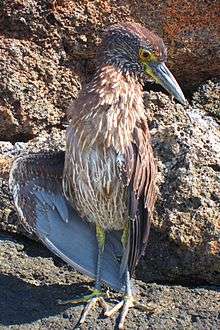Lava heron
| Lava heron | |
|---|---|
 | |
| Adult specimen on Santa Fe Island | |
| Scientific classification | |
| Kingdom: | Animalia |
| Phylum: | Chordata |
| Class: | Aves |
| Order: | Pelecaniformes |
| Family: | Ardeidae |
| Genus: | Butorides |
| Species: | B. sundevalli |
| Binomial name | |
| Butorides sundevalli (Reichenow, 1877) | |
| Synonyms[1] | |
|
Butorides striata sundevalli | |
The lava heron (Butorides sundevalli), also known as the Galápagos heron, is a species of heron endemic to the Galápagos Islands of Ecuador. It is considered by some authorities — including the American Ornithologists' Union and BirdLife International — to be a subspecies (or even just a colour morph) of the striated heron (B. striata), and was formerly "lumped" with this species and the green heron (B. virescens) as the green-backed heron.[1]
Description

The adult is slate-grey, which allows it to blend in with the hardened lava. The back feathers typically have a silvery sheen and it has a short crest on its head. When breeding, the heron has a black beak and bright orange legs, but these fade to grey after the breeding season.
Distribution and habitat
These highly territorial birds are found in intertidal zones and mangrove swamps on all of the islands of Galápagos Province.
Behavior
The lava heron stalks small crabs and fish slowly before quickly spearing and eating them. They have also been known to eat the flies that gather near cacti.
Lava herons are typically seen hunched over and they have a sharp alarm call. These birds have little fear of humans.
Breeding
Unlike most herons, these birds nest in solitary pairs in either the lower branches of mangrove trees or under lava rocks. They can breed year-round, though typically from September to March, and can mate up to three times a year.
Footnotes
- 1 2 "Galapagos heron". Avibase.
References
- Heinzel, Hermann and Barnaby Hall. Galapagos Diary. Los Angeles; University of California Press, 2000.
- BirdLife International (BLI) (2008). "Butorides striata". IUCN Red List of Threatened Species. Version 2008. International Union for Conservation of Nature. Retrieved 7 January 2008.